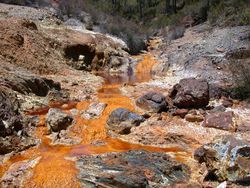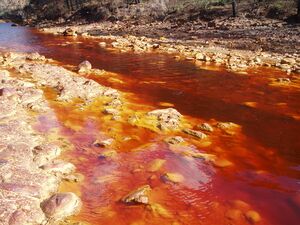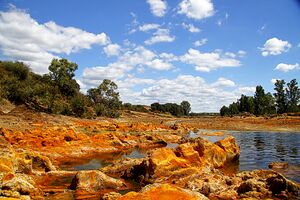نهر لبلة
| Río Tinto Tinto River | |
|---|---|
 Rio Tinto | |
 Course of the Rio Tinto | |
| الموقع | |
| Country | Spain |
| Region | Andalusia |
| السمات الطبيعية | |
| المنبع | Sierra Morena |
| ⁃ الموقع | Andalusia |
| المصب | |
- الموقع | Gulf of Cádiz |
- الإحداثيات | 37°12′36″N 6°56′17″W / 37.21°N 6.938°W |
| الطول | 100 km (62 mi) |
| التدفق | |
| ⁃ الموقع | Huelva |
 | |
نهر لَبْلَة[1] (بالإسبانية: Río Tinto) نهر يسيل في مقاطعة ولبة من جنوب غربي إسبانيا، وهو يصبّ في وادي ولبة عند الاجتماع بنهر وديال.
The river maintains its colour for an approximate length of 50 kilometres.[2] After the 50 kilometre mark, the chemistry that makes the Rio Tinto river so unique appears to slowly decline, as does the odd colouring. The location where the chemistry of the river is altered is near a town called Niebla.[2] The river's chemistry begins to significantly change following the town of Niebla owing to the fact that the Rio Tinto blends itself with other streams that are connected to the Atlantic Ocean.[2] The river is approximately 100 km (62 mi) long and is located within the Iberian Pyrite Belt.[3] This area has large amounts of ore and sulfide deposits.
The Rio Tinto area has been the source of approximately 5,000 years of ore mining,[4] including copper, silver, gold, and other minerals,[5] extracted as far as 20 kilometres from the river shores.[2] As a possible result of the mining, the Río Tinto is notable for being very acidic (pH 2) and its deep reddish hue is due to iron dissolved in the water. Acid mine drainage from the mines leads to severe environmental problems because the acidity (low pH) dissolves heavy metals into the water. It is not clear how much acid drainage has come from natural processes and how much has come from mining. There are severe environmental concerns over the pollution in the river.[2]
Although the river represents a harsh environment for life, some microorganisms classified as extremophiles do thrive in these conditions. Such life forms include certain species of bacteria, algae and heterotrophs.[6]
. . . . . . . . . . . . . . . . . . . . . . . . . . . . . . . . . . . . . . . . . . . . . . . . . . . . . . . . . . . . . . . . . . . . . . . . . . . . . . . . . . . . . . . . . . . . . . . . . . . . . . . . . . . . . . . . . . . . . . . . . . . . . . . . . . . . . . . . . . . . . . . . . . . . . . . . . . . . . . . . . . . . . . . .
التاريخ
The ore body was deposited during the Carboniferous period (300–350 Ma) by hydrothermal activities on the sea floor. The history of mining in the Rio Tinto area traces back to the Tartessans and the Iberians starting mining in 3000 BC, followed by the Phoenicians, Greeks, Romans, Visigoths, and Moors. The Rio Tinto region has been the source of approximately 5,000 years of ore extraction,[4] and chemical refinement primarily for copper, silver and gold, and later for iron, manganese and other minerals.[5] This long standing mining activity has vastly modified the topography of the region.[4]
After a period of abandonment, the mines were rediscovered in 1556 and the Spanish government began operating them once again in 1724.[5] In the 19th century, companies from the United Kingdom started large-scale mining operations. In 1873, the Rio Tinto Company was formed to operate the mines. Production declined after the peak of production in 1930, and it ended in 1986 for copper mining and in 1996 for silver and gold mining.[7] All mining ended in 2001.[8]
Increased copper prices in the 2010s led to efforts by EMED Mining to reopen the mine, but difficulties in acquiring all necessary property rights, environmental concerns, and obtaining regulatory approval delayed reopening. The mine, which employed as many as 20,000 in the past, would employ 350 people during its startup phase. Environmental concerns are centered on long disused water reservoirs which might not be able to withstand the stress of renewed waste inputs.[8]
الجدل حول طبيعة النهر
Due to the extreme conditions of the river, there is very little in the way of life, with the exception of small amounts of microorganisms, including algae. The presence of anaerobic bacteria in the sediments is thought to contribute somewhat to the river's famously low pH (acidity), that in turn increases the concentration of dissolved heavy metals. The waters from the Rio Tinto, high in metal sulfides, provide an ideal environment for chemolithoautotrophic microorganisms, with the sulfides acting as a food source. The product of metal sulfide metabolism through oxidization is ferric iron and secretion of acidic liquid. The continuation of this process for an extended period of time is thought by some scientists to be responsible for keeping the river's pH between 2 and 2.5 in most areas. Even in the extremely acidic water, both red and green algae have been observed to thrive in relatively high concentrations.[9] Despite algae levels in the Rio Tinto accounting for over half of the total biomass in the river, algae is understood to have minimal effects on the characteristics of the complex ecosystem.[2]
The discovery of multiple oxide terraces mediated by microorganisms at up to 60 meters above the current water level, and as far away as 20 kilometers from the current river's path, may suggest that the unusual ecosystem is a natural phenomenon since before human mining activities started in this region.[10] On the other hand, it is known that toxic water emanates from these vast underground and open pit mines and chemical ore refinement that had been active off and on for thousands of years.[11] While it is still undetermined if the unique water chemistry of the Rio Tinto developed as a result of thousands of years of mining or by natural causes, it is possible that the river's chemical makeup is due to the combination of both natural causes and acid mine drainage.[12][13][14] The river drains an area with huge deposits of sulfides which was formed more than 350 million years ago. When sulfides are exposed to air, water, and microorganisms, drainage from acidic rocks flows into surface and ground water. Mining, however, greatly increases exposed areas.[13]
علم الأحياء الفلكي
This river has gained recent scientific interest due to the presence of extremophile anaerobic bacteria that dwell in the acidic water. The subsurface rocks on the river bed contain iron and sulfide minerals on which the bacteria feed.[15][16][17] The extreme conditions in the river may be analogous to other locations in the Solar System thought to contain liquid water, such as groundwater on Mars. Scientists have also directly compared the chemistry of the water in which the Mars rocks of Meridiani Planum were deposited in the past with the Río Tinto.[18] Likewise, the moon Europa contains an acidic[مطلوب مصدر أفضل] ocean of water underneath its ice surface, thus the Rio Tinto river is of interest to astrobiologists studying the environmental limits of life and planetary habitability.[12]
انظر أيضاً
المراجع
- ^ «وهناك ذراع من البحر يتصل به موقع نهر لبلة ويتسع حتى يكون أزيد من ميل ثم لا يزال الصعود فيه في المراكب إلى أن يضيق ذلك الذراع حتى يكون سعة النهر وحده مقدار نصف رمية حجر ويخرج النهر من أسفل جبل عليه مدينة ولبة ومن هناك تتصل الطريق إلى لبلة.» الإدريسي، نزهة المشتاق في اختراق الآفاق.
- ^ أ ب ت ث ج ح Fernández-Remolar, David C.; Morris, Richard V.; Gruener, John E.; Amils, Ricardo; Knoll, Andrew H. (2005). "The Río Tinto Basin, Spain: Mineralogy, sedimentary geobiology, and implications for interpretation of outcrop rocks at Meridiani Planum, Mars". Earth and Planetary Science Letters. 240 (1): 149–167. Bibcode:2005E&PSL.240..149F. doi:10.1016/j.epsl.2005.09.043.
- ^ خطأ استشهاد: وسم
<ref>غير صحيح؛ لا نص تم توفيره للمراجع المسماة:03 - ^ أ ب ت Fernández-Remolar, David C.; Morris, Richard V.; Gruener, John E.; Amils, Ricardo; Knoll, Andrew H. (2005). "The Río Tinto Basin, Spain: Mineralogy, sedimentary geobiology, and implications for interpretation of outcrop rocks at Meridiani Planum, Mars". Earth and Planetary Science Letters. 240 (1): 149–167. Bibcode:2005E&PSL.240..149F. doi:10.1016/j.epsl.2005.09.043.
- ^ أ ب ت Bordenstein, Sarah. "Rio Tinto, Spain". Science Education Resource Center. Carleton College. Retrieved March 3, 2009.
- ^ Fernández-Remolar, David C.; Morris, Richard V.; Gruener, John E.; Amils, Ricardo; Knoll, Andrew H. (2005). "The Río Tinto Basin, Spain: Mineralogy, sedimentary geobiology, and implications for interpretation of outcrop rocks at Meridiani Planum, Mars". Earth and Planetary Science Letters. 240 (1): 149–167. Bibcode:2005E&PSL.240..149F. doi:10.1016/j.epsl.2005.09.043.
- ^ Davis, R. A. Jr.; Welty, A. T.; Borrego, J.; Morales, J. A.; Pendon, J. G.; Ryan, J. G. (2000). "Rio Tinto estuary (Spain): 5000 years of pollution". Environmental Geology. 39 (10): 1107–1116. doi:10.1007/s002549900096. S2CID 130535502.
- ^ أ ب Minder, Raphael (April 12, 2012). "In Struggling Spanish Town, Hopes of Reopening Mine Are Delayed". The New York Times. Retrieved April 13, 2012.
- ^ Sanz, José L.; Rodríguez, Nuria; Díaz, Emiliano E.; Amils, Ricardo (2011-08-01). "Methanogenesis in the sediments of Rio Tinto, an extreme acidic river". Environmental Microbiology (in الإنجليزية). 13 (8): 2336–2341. doi:10.1111/j.1462-2920.2011.02504.x. hdl:10261/57674. ISSN 1462-2920. PMID 21605308.
- ^ Fernández-Remolar, David C.; Morris, Richard V.; Gruener, John E.; Amils, Ricardo; Knoll, Andrew H. (2005). "The Río Tinto Basin, Spain: Mineralogy, sedimentary geobiology, and implications for interpretation of outcrop rocks at Meridiani Planum, Mars". Earth and Planetary Science Letters. 240 (1): 149–167. Bibcode:2005E&PSL.240..149F. doi:10.1016/j.epsl.2005.09.043.
- ^ Rio Tinto: the River, the Mine and the Corporation Still Polluting After All These Years. Gary G. Kohls, MD, Duluth Reader. June 2015.
- ^ أ ب Rio Tinto, Spain. Sarah Bordenstein, Marine Biological Laboratory. Microbial Life Educational Resources. 21 June 2013.
- ^ أ ب Rio Tinto and the Mines: The long-dormant site of Spain's first environmental protest in 1888, revisited. Adam Lederer and Vicky Azcoitia. Natural History Magazine. May 2017.
- ^ Rio Tinto river, the Martian-like environment in southwest Andalucia. Andrew Forbes. 11 October 2013. Quote: "there’s natural contamination from the iron in the earth as well as heavy metal contamination from the disused mines."
- ^ Fernández Remolar, D. C.; Morris, R. V.; Gruener, J. E.; Amils, R.; Knoll, A. H. (2005). "The Rio Tinto basin, Spain: Mineralogy, sedimentary geobiology, and implications for interpretation of outcrop rocks at Meridiani Planum, Mars". Earth and Planetary Science Letters. 240 (1): 149–167. Bibcode:2005E&PSL.240..149F. doi:10.1016/j.epsl.2005.09.043.
- ^ Fernández Remolar, D. C.; Rodríguez, N.; Gómez, F.; Amils, R. (2003). "Geological record of an acidic environment driven by iron hydrochemistry: The Tinto River system". Journal of Geophysical Research: Planets. 108 (E7): 5080. Bibcode:2003JGRE..108.5080F. doi:10.1029/2002JE001918.
- ^ Sánchez Andrea, I; Rodríguez, N; Amalis, R; Sans, J. L. (2011). "Microbial diversity in anaerobic sediments at Rio Tinto, a naturally acidic environment with a high heavy metal content". Applied and Environmental Microbiology. 77 (17): 6085–6093. doi:10.1128/AEM.00654-11. PMC 3165421. PMID 21724883.
- ^ Guy Webster (2005-11-29). "News | NASA Rover Helps Reveal Possible Secrets of Martian Life". Jpl.nasa.gov. Retrieved 2017-01-16.
°37 15' 00" شمالا 06° 53' 45" غربا
- Pages using gadget WikiMiniAtlas
- Short description is different from Wikidata
- Articles with hatnote templates targeting a nonexistent page
- Missing redirects
- Coordinates on Wikidata
- كل المقالات بدون مراجع موثوقة
- كل المقالات بدون مراجع موثوقة from March 2021
- أنهار إسپانيا
- أنهار أندلوسيا
- Environmental impact of mining
- Environmental issues in Spain
- Mining in Spain
- صفحات مع الخرائط


